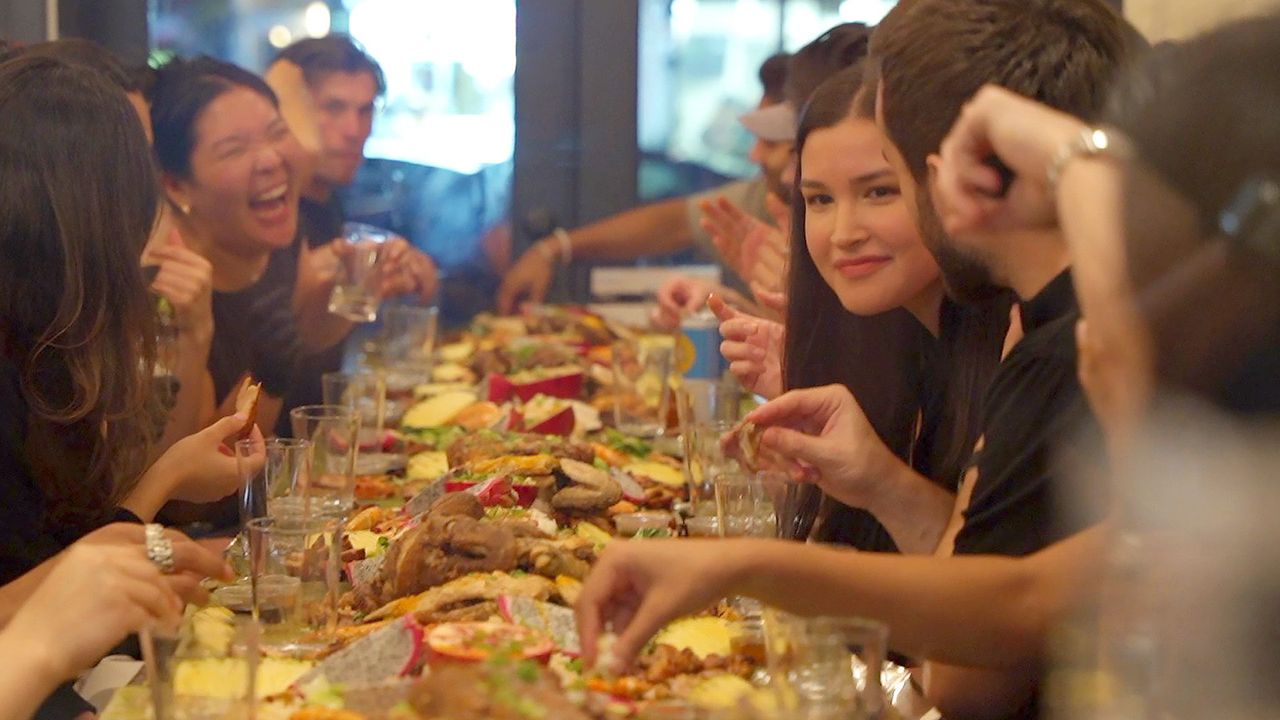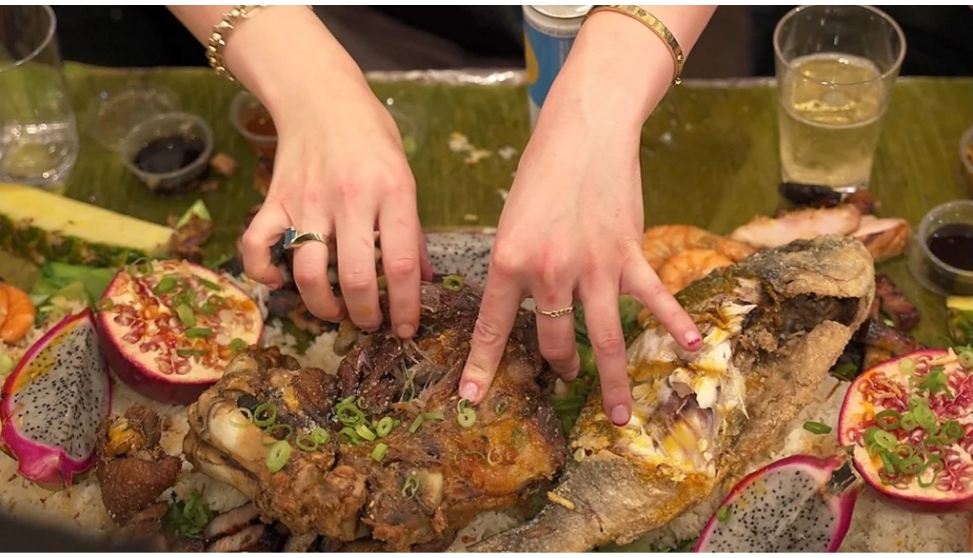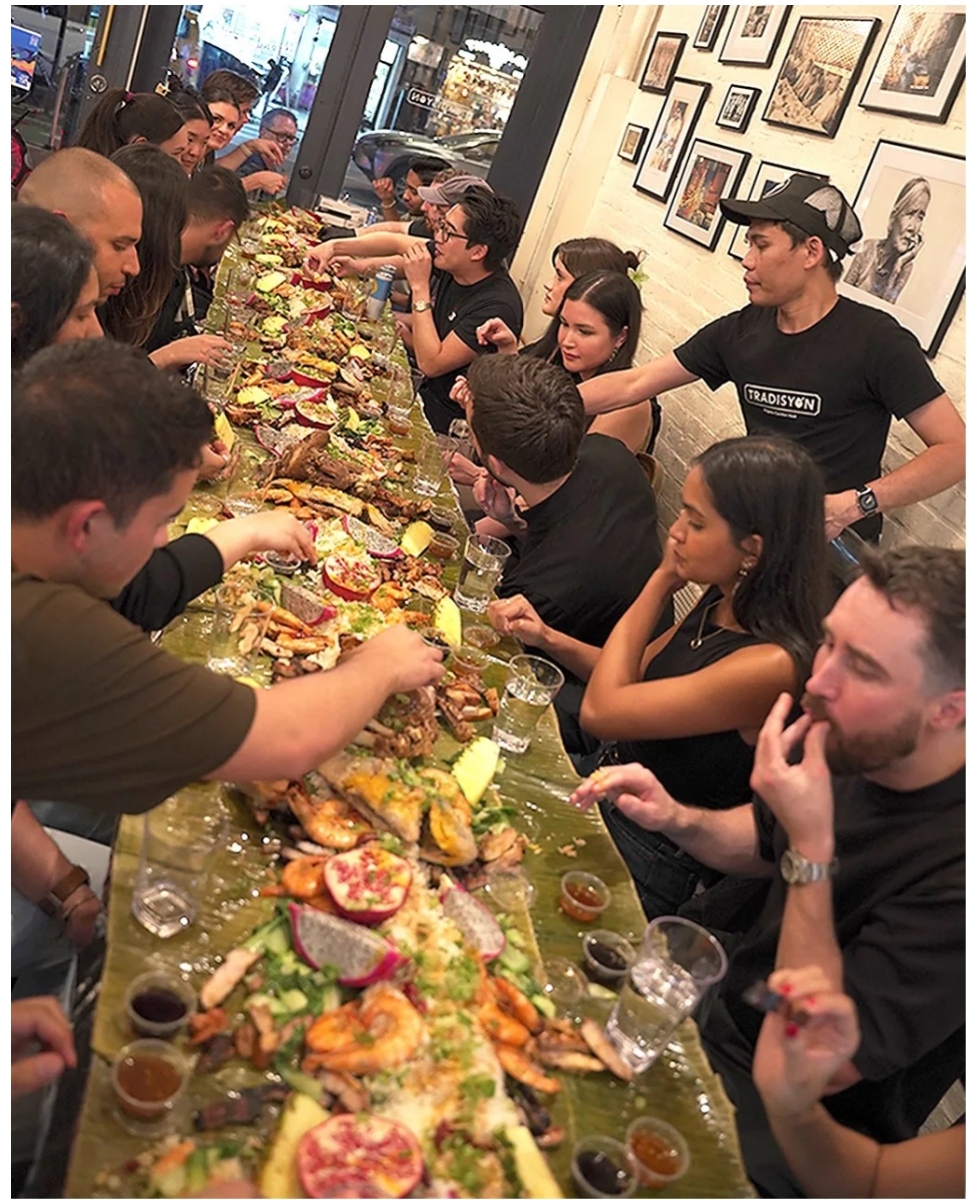Kamayan feasts : The ‘hands-only’ meals that bring Filipinos together

By Francis Augustin
Swept aside by colonialism, this ancient tradition is being reclaimed by a new generation of Filipino chefs who are introducing it to the world.
On an early Friday evening, customers slowly filtered out of a small Filipino restaurant in Manhattan’s Hell’s Kitchen neighbourhood. Rattan-wrapped fixtures hung from the ceiling, bouncing light off the dining room’s white-brick interior and mirrored wall, and the wafting scents of garlic and vinegar filled the modest 400-sq-ft space.
During its normal restaurant hours, Tradisyon is a quick-service spot serving familiar Filipino comfort fare, like adobo-rice bowls and noodle dishes. But as night settles, something special brews in the back kitchen.
After all the regular dinner guests left, chef Anton Dayrit and his team combined all the restaurant’s tables and chairs so they ran the entire length of the dining room. Moving swiftly past each other in a rehearsed choreography, they wrapped the conjoined table in foil and laid several four-foot-long banana leaves across it for an incoming 20-person meal, a dinner package that anyone can book by phone or email.
This wasn’t just any dinner but a version of kamayan: a communal Filipino feast where all the food is laid out on the leafy greens and instead of using plates or utensils, everything is eaten with your hands (“kamayan” in Tagalog). Much like a Japanese omakase meal, the dishes served during a kamayan feast vary depending on the vision of the chef who cooks it. The idea is to present a cornucopia of classic Filipino foods that complement each other when eaten together.

At Tradisyon, kamayan feasts typically include crispy pata (fried pork knuckles), garlic chilli prawns and fried fish (Credit: Darryl Laiu/ BBC)
Eating with one’s hands is something that’s practiced in many West African, Middle Eastern and South Asian cultures. But unlike in other regions where the custom has persisted for centuries, kamayan-style dining harkens back to the Philippines’ Indigenous roots but was largely swept aside during Spanish rule, starting in the 16th Century.
The practice therefore not only serves as a reminder of how Filipinos ate before colonialism and a physical connection to Filipino heritage, but also as a way of preserving that cultural history in Filipino communities around the world.
In the Philippines today, kamayan meals are typically prepared on important family occasions, like birthdays, holidays and reunions, and are also offered on some restaurant menus. But these feasts have been regarded with a renewed sense of dignity among Filipino and Filipino American chefs, who are keeping the tradition alive in their restaurants and introducing it to a new set of diners abroad.
Tradisyon is one of a handful of restaurants in Manhattan offering these hand-eaten kamayan feasts as special packages for big groups.Compared to other Asian cuisines like Vietnamese, Chinese and Japanese that have become ubiquitous in major cities, Filipino food has had a much quieter international presence.
This may be partly due to the nation’s incredible diversity: more than 100 ethnic groups, each with different languages, cultures and culinary practices, call the archipelago home, making it more difficult to pin down what, exactly, Filipino food is.
But thanks to praise from US celebrity chefs like Anthony Bourdain (who proclaimed his love for the sizzling pork dish sisig) and Andrew Zimmern (who recently told the BBC, “It combines all the best Asian techniques, textures and flavours… Filipino food is just as good as it gets”), Filipino cuisine has flourished over the past decade – especially as chefs in the States have spun Filipino dishes in ways that have gradually introduced its flavours to foreign palates.
Filipino food and its communal meals recently trended on social media, and the growing popularity of dishes like kare-kare (oxtail in a peanut stew), pancit (a Filipino noodle dish) and the nation’s now-famous technicolour yam ube led food research company Tastewise to recently name Filipino food as one of the “most disruptive food and beverage trends of 2025”.
Nicole Ponseca, a Filipino chef and James Beard Award finalist who was integral in popularising restaurant-set kamayan feasts in New York City, recalled growing up somewhat ashamed of seeing family members eating with their hands.
“When I opened my first restaurant, it was always in the back of my head to turn everything I was embarrassed about into something I could lean into for a source of integrity and self-esteem,” she said.
That first restaurant was Jeepney, a former East Village gem whose kamayan menu included a selection of seasoned pork, whole fish and marinated beef, alongside lumpia (egg rolls), deep-fried shrimp and sweet longanisa pork sausage.
Recently, Ponseca has started a similar kamayan concept in Miami.
Boodle fights
Eating with one’s hands was a common among Filipinos for much of their early history. However in the 16th Century, Spanish colonisers introduced forks, spoons and plates in their attempt to assimilate the Indigenous Filipino population.
Later, during American colonial rule from 1898 to 1946, the US military spread food out on tables for cadets, co-opting the practice of kamayan to promote camaraderie between American and Filipino soldiers.
This became known as “boodle fights”, which was based on a slang term for “treats”. The term has since been used interchangeably with kamayan, but Ponseca says this phrasing is problematic.
“The idea of a boodle fight evokes a derogatory term of the soldiers fighting over their food and eating anything… meaning they’ll eat slops,” Ponseca tells the BBC. “There’s something lost in translation when we use these terms.”Dayrit considers kamayan feasts the “ultimate get-together meal”.
As a child on the beaches of Boracay and Puerto Galera, he remembers watching his yayas (nannies or caretakers) cooking up what he considered “Michelin-grade” food by the sea. “You’re on the beach, you don’t have any utensils, but you’ve got everything [you need],” he said.
“You’ve got a grill to cook, you’ve got a fire going, a table and banana leaves.”Back at Tradisyon, Dayrit and his team continued setting up their kamayan dinner. With blowtorches, chefs charred the glossy banana leaves as an almost sacrosanct precursor to the procession of food.
Flitting back-and-forth from the kitchen, the crew carried out pounds of meat, seafood and vegetable concoctions, distributing them across the table.

Though there isn’t a single way of eating kamayan, Chef Anton Dayrit shows a traditional method of cradling the food in a sort of rice pouch (Credit: Darryl Laiu/ BBC)
First, a bed of steamed white and fragrant garlic rice was spooned in a line down the centre of the leaves. Next, they placed pieces of smoky grilled pork and barbecued chicken, and large pata (deep-fried pork knuckle) with crispy golden-brown skin and succulent meat.
Garlic chili butter prawns, sauteed bok choy and whole fried dorado fish cradled the spaces around the meats, and an aromatic jus was poured onto the rice mounds. The spread was finished with a colourful medley of dragon fruit, pomegranate and pineapple slices.Our food is love, and kamayan is about abundance, it’s about joy, it’s about sharing – Nicole Ponseca
As the preparation wrapped up, I spoke with diners congregating outside who were watching the chefs construct the kamayan table through the window.”Even though I’ve visited the Philippines occasionally over the years and have heard of kamayan, I had never actually tried it myself,” said Kimberly Remijan, who booked the feast to celebrate her birthday with friends.
“Being half-Filipina, I wanted to show my friends a part of Pinoy [a colloquial term for Filipino] culture. A huge part of Pinoy culture is food.”
As the group finally filtered into the tight space, they emitted a mix of “oohs” and “aahs” before settling around the table. Dayrit showed the group the “proper” way to kamayan.
With one hand, they pressed meats into a padding of rice and wrapped it into a sort of rice pouch with the tip of their fingers. After dipping the mound in a spicy vinegar sauce, they brought the food up using their thumb to deliver the food from the fingers to the mouth without the fingers entering the mouth. It’s a skill that requires some practice.

BBC Travel Kamayan-style feasts are increasingly offered in Filipino restaurants – sometimes feeding upwards of 20 people (Credit: Darryl Laiu/ BBC)
“There’s actual chemistry when you touch food with your hands and put it in your mouth,” said Dayrit. “It somehow tastes better; I can’t explain it.”
As I marvelled at the elaborate spread before me, laughing and chatting with the diners, it felt as though I had been welcomed into this tight-knit group of friends. It was an inviting warmth that transported me back to my Filipino family and the many kamayan feasts they recalled enjoying over the years.
My father once told me about bayanihan, a Tagalog word that means “being a community”. Bayanihan represents a spirit of hospitality and kindness akin to treating others like family, and that spirit permeates the kamayan dinner.
“Before we might be eating in the shadows of our kitchen with our hands out of embarrassment. Now it’s on full display,” said Ponseca.
“Our food is love, and kamayan is about abundance, it’s about joy, it’s about sharing. In its modern version, it’s about pride.”




